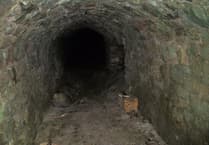Letter to the Editor: From 1835 to 1902, Cannop Chemical Works were established on Crown land known as Cannop Bridge.
They used traditional charcoal and wood distillation processes, including the manufacture of black powder for wartime munitions.
However with the advent of World War One, a wood distillery plant was set up south of the road using more refined processes on an industrial scale producing acetone crucial to mix nitro-glycerine, guncotton and a petroleum derivative for the manufacture of cordite munition propellants.
Unfortunately during wartime conditions, the surplus by-products of wood tars and other toxic chemical were dumped into a watery bog eastwardly surrounding the raised area where the Wood Distillation Ltd was established.
This practice of disposing surpluses materials by pouring down into the bog where tars have solidified forming mounds, included dumping chemical drums have, over the years, corroded emptying their contents and many have risen to the surface.
Years ago I was invited to visit the site with electronic expert Edward Chetchuti following a huge lightening strike which smashed the boles of an entire patch of trees, which was an incredible sight.
I’ve recently returned with people opposed to Forestry England and their consultants weighted option of draining Cannop Ponds.
These good folk include dedicated Save The Ponds Campaigner, Brian Harding, members of Dean Forest Voice and the Commoners’ Association.
Rather than simply criticising, we have come together with alternatives to closing all the ponds which involves extensive works and great expense and loss of wild life, fishing, flora and the idyllic heart of the Dean which Cannop Ponds undoubtably provides.
Local contractors or the Forestry could cut another channel linked with a sluice gate to take uncontaminated water from the stream close to the Speech House road to bypass the toxic area and silted top pond into the middle pond to protect the integrity of wildlife and fishing of the lower ponds.
The affected areas could then be drained if required and treated and restored.
Brian Harding and I managed to access the dangerous bog while finding and photographing 29 abandoned chemical drums.
It took two visits and each time I had to wash all my clothes of the stench from carcinogenic tars.
What was so disturbing is that the area is unfenced which allows animals, including the wild boar to wallow in toxic pools gouged out in the tar stratifying the area, after which the stained trees provide evidence of how the wild boar rub themselves dry.
Many of these poor animals must have been poisoned over the years.
I will conclude by stating the obvious requirement as follows;
This top, poisonous, area of bogs must be fenced off with signage immediately.
We don’t need risk assessment, further time wasting tests before further animals and, indeed, children playing get caught up in this quagmire.
The lower ponds at Cannop must not be drained, because they represent the core heritage of the Forest and Foresters alike, once drained they will never return.
Andrew Gardiner, Ruardean




